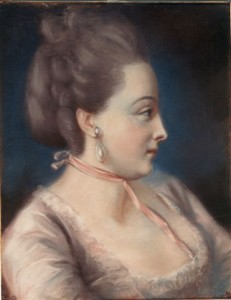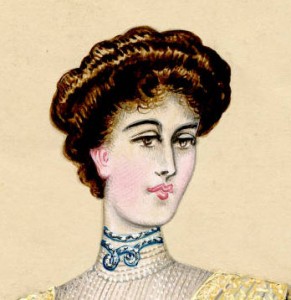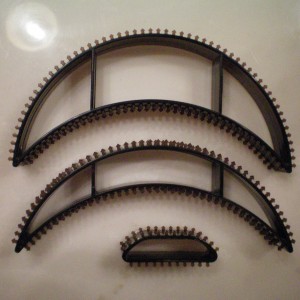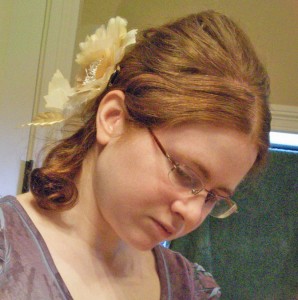Tuesday’s Tips and Tricks
A Rat’s Nest
Throughout many historic time periods, the fashion for hair was huge. As near as I can tell, it began in the 17th century with the frizzed Elizabethan styes. In the late 18th century, the pouf became popular, followed by ever-increasing heights of teased, ratted, and frizzed hair. Large hair made a comeback in the 1870s, and again with the Pompadour and Gibson styles that began in the 1890s and lasted for nearly twenty years. Large hair has returned on and off throughout the modern era, as well, such as the Victory Roll during the late 1940s and the teased styles of the 1990s.
In times past, women had access to wire frames upon which to spread their hair in order to create the broad styles that fashion demanded. These days, hairstyles are more natural in appearance, so what’s a modern girl to do when she wants to achieve a properly massive historic style?
One trick used by our ancestors was a device called a rat. So called because of its resemblance to a rodent, a rat is simply a small pad used to add height to a hairstyle. Rats were often made of a woman’s own hair, saved from her hairbrush and teased into an oval shape. The hair can be placed inside a hairnet to help contain it. The rat is placed against the scalp, and the real hair is combed over it, providing instant lift and height. There are modern rats, typically made of foam, available from wig and hair supply shops, but these can be harder to pin in place, and you can’t always match your hair color.
If the idea of saving your own hair doesn’t appeal, consider a product called Bumpits®. The modern woman’s answer to the old-fashioned rat, the Bumpits insert is a crescent-shaped device, made of hard plastic, with tiny teeth that help it grip your hair. It’s available in three colors (dark brown, light brown, and blonde) and is packaged in sets of three: you get one each of large, medium, and tiny. As the instructional booklet shows, the device can be used in a variety of ways, from jazzing up a simple ponytail to adding style to an elegant updo.
It’s my understanding that Bumpits are mainly used by girls attending the prom, but there’s no reason you couldn’t appropriate the device for your own historic purposes.
The next time you need a poofy hairdo for your reenactment, no matter the century involved, why not consider using a rat made of your own hair, or perhaps the modern equivalent?
~~*~~
Have you found any tricks that help you create an historical hairstyle? Please share!
-
Disclaimer: Yesterday’s Thimble is in no way affiliated with Big Happie Hair, Inc., Allstar Products Group, or their product, Bumpits®. We simply found the product on clearance for $2.99 and decided to try it.






Pingback: Improving Theatrical Costumes, Part 3 | Foundations Revealed
Thank you for the interesting and informative article. I was a teenager in the sixties and ‘ratting’ your hair was huge back then. By that I mean back combing or teasing. The term teasing came to be used more and more as ‘ratting’ fell out of favor. At least this is how it was in rural central Ohio in the days when there was no internet!
I have pictures of my grandmother with rats in her hair. She was born in 1905. Anyway thanks again for the history lesson!
I was researching lyrics to the 1910 song: “Any Little Girl, That’s A Nice Little Girl…”, and had no idea what “rats” were. Thank you for posting this. Now I’m going to try to find “Straight front X. Y. Z.”
The chorus is:
Any little girl, that’s a nice little girl, is the right little girl for me.
She don’t have to look like a girl in a book,
If a good cook she should be.
She don’t have to wear rats in her hair,
Or a straight front X. Y. Z.,
Any little girl, that’s a nice little girl, is the right little girl for me.
“Straight-front” is a type of corset commonly worn in the Edwardian period. Unlike the earlier Victorian corsets, which were shaped to curve inward at the front waist and outward over the belly, the straight-front corset had a completely straight front (hence the name) that pushed the stomach and hips backwards, forcing an unnatural posture. It was extremely popular for a short time.